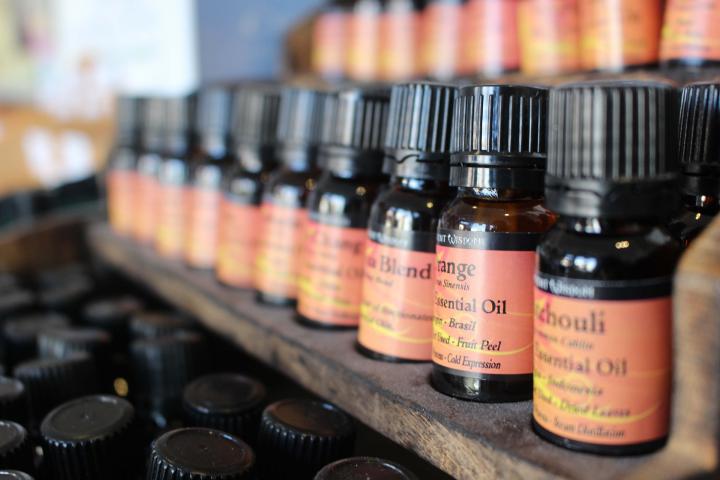Lately, I’ve been seeing a lot of headlines about essential oils in connection to health. What are they, and why the big deal?
What Are Essential Oils?
An essential oil is the liquid distilled from a plant that contains the phytochemicals that give the plant its characteristic aroma and flavor. They get their name because they represent the aromatic “essence“ of the plant they came from.
Age-Old Practice
They may be trendy, but they’re not new. Chances are you or someone in your family has used an essential oil at one time or another. For example:
- Maybe grandpa applied clove oil to ease a toothache, or grandma dabbed a drop of attar of roses behind her ears.
- Perhaps your mom followed the advice of the old nursery rhyme John Brown’s Baby, and laid a warm, camphor-oil infused flannel cloth on your chest to relieve congestion.
- You prefer essential flavoring oils over alcohol extracts for cooking (think peppermint oil in your favorite holiday cookies, or lemon oil for pies and puddings).
- Your medicine cabinet contains a bottle of tea-tree oil for use as an all-purpose antiseptic.
- You use a citrus-peel household cleaning solvent that contains an essential oil made from the rinds left over from the orange juice business.

Humans have made and used essential oils for around 6,000 years, as perfumes and cosmetics; for use as embalming fluids, poisons, antiseptics, and insect controls; to flavor and preserve food; and for a broad variety of medicinal purposes. There’s ongoing scientific research into essential oils for all these purposes today.
The modern interest in the therapeutic uses of essential oils coincides with the public’s growing enthusiasm for “complementary and alternative” healing strategies. But it’s hard not to feel overwhelmed when you dip into the popular articles about essential oils, not to mention the advocacy claims, the celebrity endorsements, the testimonials, and the rows and rows of them on the shelves of natural-food stores. So many oils, so many uses!
Popular Essential Oils Today
Humans have made and used essential oils for around 6,000 years, as perfumes and cosmetics; for use as embalming fluids, poisons, antiseptics, and insect controls; to flavor and preserve food; and for a broad variety of medicinal purposes. There’s ongoing scientific research into essential oils for all these purposes today.
You’ll often find essential oils made of our favorite herbs from rosemary to mint. Here are three favorites which are backed by supportive research.
- Tea tree oil has proven anti-fungal and anti-inflammatory properties. Research also suggests tea tree oil fights athlete’s foot, nail fungus, and other problems. Never ingest tea tree oil nor apply it directly to the skin; it needs to be used with a carrier oil.
- Lavender is often used under the pillow to aide sleep, but its soothing essence doesn’t just calm you down. Studies have shown lavender essential oil may also have anti-inflammatory and pain-relieving benefits.
- Peppermint essential oil helps relieve headaches and ease tension. Again, avoid applying directly to the skin and dilute in a carrier oil. Ever enjoyed peppermint tea? Peppermint’s properties also ease the tensions of the stomach muscles and ease bloating.
A few caveats
- The FDA forbids essential-oil marketers from making health claims for these products. Otherwise, there’s no government regulation of essential oils, and no standards of quality or purity.
- Although licensed massage therapists, nurses and midwives, and other licensed health care professionals may use essential oils in their practice, there are currently no regulations or official licenses that govern the practice.
- Because pure essential oils tend to be very expensive (e.g., it takes about 220 lbs of lavender flowers to make about a pound of lavender essential oil), many products on store shelves bearing the “essential-oil” label have been cut with other ingredients, which may include vegetable oils and synthetic fragrances.
- As compared with teas, infusions, and tinctures, pure essential oils are highly concentrated sources of plant chemicals. When used in massage therapy, they’re greatly diluted in a so-called carrier oil. For steam inhalations, experts recommend using only a few drops of essential oil in the water producing the steam.
- When used as directed, essential oils are remarkably safe and produce few side effects. However, medical experts caution against their use on infants and young children, by pregnant women, and people with seizure disorders unless under the direction of a licensed medical professional.
- Some essential oils may interfere with prescription medications, so it’s important to check with your doctor before you try one.
Medical research on the therapeutic value of various essential oils has confirmed the value of some for antiseptic uses, pain, anxiety relief, insomnia, and treating a variety of skin conditions. Check out the aromatherapy website linked below for more specific information.
Learn more












Comments